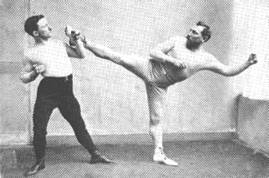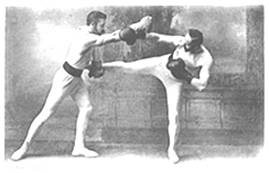|
Who's Who in
Savate
Charles Lecour
|
History of Savate
by Terence Bridgeman
 
Savate (pronounced /savat/),
also known as boxe fran�aise (French boxing), French Kickboxing or
French Footfighting, is a French martial art which uses both the
hands and feet as weapons and contains elements of western boxing,
grappling and graceful kicking techniques (only foot kicks are
allowed, unlike some systems such as Muay Thai which allow the use
of the knees or shins). A practitioner of savate is called a
savateur (male) or savateuse (female).
Savate takes its name
from the French for old boot (heavy footwear that used to be worn
during fights). The modern formalized form is mainly an amalgam of
French street fighting techniques from the beginning of the 19th
century[1]. Savate was then a type of street fighting common in
Paris and northern France. In the south, especially in the port of
Marseille, sailors developed a fighting style involving high kicks
and open-handed slaps. It is conjectured that the kicks were done so
as to allow the kicker to use a free hand for balance on a rocking
ship's deck, and that the kicks and slaps were used on land to avoid
the legal penalties for using a closed fist, which was considered a
deadly weapon under the law. It was known as jeu marseillais (game
from Marseille), and was later renamed chausson (slipper, after the
type of shoes the sailors wore). In contrast, at this time in
England (the home of boxing and the Queensberry rules), kicking was
seen as unsportsmanlike.
The two key historical figures in the history of the shift from
street fighting to the modern sport of savate are Michel Casseux
(also known as "le Pisseux") (1794-1869) and Charles Lecour
(1808-1894). Casseux opened the first establishment in 1825 for
practicing and promoting a regulated version of chausson and savate
(disallowing head butting, eye gouging, etc). However the sport had
not shaken its reputation as a street fighting technique. Casseux's
pupil Charles Lecour was exposed to the English art of boxing when
he was defeated in a friendly sparring match by British pugilist
Owen Swift around 1830 and felt that he was at a disadvantage, only
using his hands to bat his opponent's feet away, rather than to
punch. He trained in boxing for two years before, in 1832, combining
boxing with chausson and savate to create the sport of savate (or
boxe fran�aise', as we know it today). At some point stickfighting
was added, and some form of stick fencing, such as la canne, is
commonly part of savate training. Those who train purely for
competition may omit this.
In competitive savate, there are four allowed kinds of kicks, and
four kinds of punches.
* Kicks:
1. fouett� (literally "whip," crescent or roundhouse kick making
contact with the reinforced toe of the shoe), high, medium or low
2. chass� (side or front piston-action kick), high, medium or low
3. revers (crescent or roundhouse kick making contact with the sole
of the shoe), high, medium, or low
4. coup de pied bas (literally, simply "low kick", a front or sweep
kick to the shin making contact with the instep of the shoe,
performed with a characteristic backwards lean) low only
* Punches
1. direct bras avant (jab, lead hand)
2. direct bras arri�re (cross, rear hand)
3. crochet (hook, bent arm)
4. uppercut (either hand)
Perhaps the ultimate
recognition of the respectability of savate came in 1924 when it was
included as a demonstration sport in the Olympic Games in Paris.
Despite its roots, savate is a relatively safe sport to learn.
According to USA Savate [2], "savate ranks lower in number of
injuries when compared to American football, hockey, Football,
gymnastics, basketball, baseball and inline skating".
Today, savate is practiced the world over by amateurs: from
Australia to the USA and from Finland to Britain. Many countries
(including the United States) have national federations devoted to
promoting savate. Savate was also featured in the first Ultimate
Fighting Championship tournament, where Dutch Savate expert Gerard
Gordeau beat a sumo wrestler and an American kickboxer before a
submission loss to Brazilian Jiu-Jitsu fighter Royce Gracie in the
final round.
Modern codified savate provides for three levels of competition:
assaut, pre-combat and combat. Assaut requires the competitors to
focus on their technique while still making contact; referees assign
penalties for the use of excessive force. Pre-combat allows for
full-strength fighting so long as the fighters wear protective gear
such as helmets and shinguards. Combat, the most intense level, is
the same as pre-combat, but protective gear other than groin
protection and mouthguards is prohibited.
Many martial arts provide ranking systems, such as belt colors.
Savate uses glove colors to indicate a fighter's level of
proficiency. (Unlike arts such as karate, which assign new belts at
each promotion, however, moving to a higher color rank in savate
does not necessarily entail a change in the color of one's actual
gloves, and a given fighter may continue using the same pair of
gloves through multiple promotions.) Novices begin at no color.
Promotion tests allow the fighter to graduate successively to blue,
green, red, white and yellow. Competition is restricted to yellow
glove rank and above, fighters at white glove rank are considered to
be instructors in training, and yellow gloves are required to teach
what they know to others and can attend a combat competition. Silver
gloves are the highest regular rank in savate. White gloves and
lower ranks can be attributed by the teacher but for the higher
ranks, the fighter must take a real exam.
Savate Videos
Savate Books
Savate
VHSs
Savate DVDs
Savate Links
|



